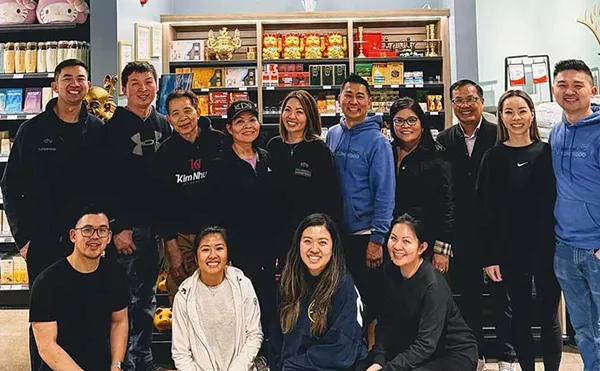
Audio By Carbonatix
[
{
"name": "GPT - Leaderboard - Inline - Content",
"component": "35519556",
"insertPoint": "5th",
"startingPoint": "3",
"requiredCountToDisplay": "3",
"maxInsertions": 100,
"adList": [
{
"adPreset": "LeaderboardInline"
}
]
}
]
Step right up, folks, and try this amazing new food. It’ll build your bones. It’ll give you energy! It’s cholesterol-free and in sufficient quantities might even help you live longer!
You still say, yuck, it’s broccoli?
Well, then, how about a nice drink of fortified soda with all those ingredients added? Much better? It’s all in the packaging, and with nutraceuticals, that is likely to list a bunch of herbs and other ingredients to make you feel better.
Nutraceuticals, or functional foods, were first marketed in the 1980s in Japan, where consumers were eager for foods that promised more than just quenching hunger.
Since then, Americans — already well-acclimatized to popping vitamin pills and herbal supplements — have caught on to the two-in-one deal of “functional foods.” The stage was set for one of the fastest-growing segments of the food industry today.
Marketing the natural
Marketers have been making claims about certain foods’ effect on human bodies for more than a half century. Who doesn’t know, for example, that milk (or, rather, the calcium in milk) builds strong bones? But for the most part, manufacturers didn’t promote individual components — until food science reached a point where scientists could identify the role of specific food components in our health.
Hence, less than a year ago, the Food and Drug Administration approved researchers’ claim that 25 grams of soy protein a day could help prevent heart disease. It was one of only 10 such health claims the FDA has approved since 1993, when it began to relax its labeling rules. Suddenly, soy marketers were promoting their products as a way for people to get their recommended daily allowance.
Gloria Averbuch is a soy-lover, athlete and spokesperson for NutriSoy, the branch of Archer Daniels Midland dedicated to marketing soy products. When you see the NutriSoy logo on a product, says Averbuch, you’ll know that soy is in the food, just like flour is an ingredient in bread.
Soy protein is added to foods from pastas to snacks. “The key is having it as an ingredient, as part of foods we customarily eat,” says Averbuch. If you choose NutriSoy-logoed, soy-enhanced linguine over regular pasta, you’ll be getting the benefits of soy while not having to come up with yet another tofu recipe.
And therein lies the appeal. Why not get more bang for your bite when you’re eating potato chips or pasta?
After 1994, when Congress allowed the herbal supplement industry to make wider claims about product benefits, the door was open for manufacturers of all sorts of foods to follow Japan’s lead and tout herbal supplements in products. In chocolate, for instance.
Adding zing
Jimmy Schmidt, chef and owner of the Rattlesnake Club in Detroit, launched SmartChocolate earlier this year. It’s available in four varieties (Memory, Passion, Energy and Serenity), but Schmidt plans to add another four and a special high-protein bar.
The 1-oz., $2.59 chocolate bars are distributed nationally via the Web (www.smartchoc.com), and through GNC and Whole Foods stores. The market is expanding rapidly, says Schmidt.
The bars have organic chocolate outer shells with truffle fillings containing such ingredients as ginseng, guarana, green tea and kava kava.
A longtime supplements fan, Schmidt says he developed the chocolate with the help of Detroit candymaker Tom Morley Jr., after unsuccessfully trying to make desserts with ginseng. (Effective ginseng doses clashed with delicately flavored confections.)
“I believe in natural remedies,” says Schmidt, who started taking ginseng to perk himself up on long sailboat races. “They’re more in synch with your body.”
His favorite is the Energy bar, which contains 400 mg of ginseng, the same as one dose of a popular ginseng supplement.
“We’re the only ones putting efficacious levels of botanicals in our products,” says Schmidt. “It gives you a good four- to five-hour boost.”
And while you may not feel instantly happier after eating the Serenity bar, it lists 225 mg of St. John’s Wort, a recommended single dose of the herb.
Schmidt sent over a package of SmartChocolate for MT writers to try. Everyone agreed the bars tasted wonderful, but did they work? Karen Fisher, MT information coordinator, who ate a Passion bar on her way home, says, “I was expecting an overwhelming urge to attack my husband, but by the time I got home I’d forgotten all about it … although I was experiencing quite a bit of passion for the chocolate.”
Aaron Warshaw, listings editor, joked that he would have to try a second Energy bar, just to be sure. “If nothing else, it’s really good chocolate,” he agrees.
But writer Ann Mullen reported a caffeine-like zing that “made me a little crazy.”
Certainly, Schmidt isn’t the only one making enhanced snacks. Your local grocer probably stocks kava kava corn chips, enhanced teas and elixirs, even breakfast cereals and soups laced with echinacea, ginseng and other ingredients. If you’re going to snack (and, hey, who isn’t?), the marketers are betting you’ll want to alleviate your junk-food guilt with a dose of good-for-you belief.
Health questions
But not everyone is convinced that noshing on nutraceuticals is good. Last July, the Center for Science in the Public Interest, a Washington, D.C.-based nonprofit devoted to food issues, complained to the FDA about more than 30 different nutraceutically enhanced foods. It asked the federal agency to halt their sales, saying further research is needed on their safety and effectiveness, and that the FDA should discourage the claims being made.
According to Ilene Ringel Heller, senior staff attorney for the center, the FDA has not given much of a response. “They tell us they’re still looking into it,” she says.
Meanwhile, functional foods are being sold, in ever-increasing numbers. I went into a Pontiac party store last week looking for plain, unherbally enhanced iced tea, and found only one type among more than two dozen varieties of souped-up Arizona, Sobe and Snapple teas.
This trend has nutritionists worried that people might replace nutritionally sound foods with neutraceutical-laced foods that aren’t otherwise better.
“There have been no long-term evaluations of these products, and we just don’t know what these foods are going to do,” says Heller.
If consumers want dietary supplements, says Heller, they should take pills to know exactly how much of what they’re getting.
“Dietary supplements in pill form have been associated with certain health risks,” she adds. For example, St. John’s Wort has been shown to interfere with the effectiveness of some HIV medications and birth control pills.
Above all, Heller says, nutraceuticals should be treated with the respect we give prescription drugs. “You wouldn’t think about putting Viagra in vegetable soup.”
Alisa Gordaneer is MT features editor. E-mail letters@metrotimes.com




